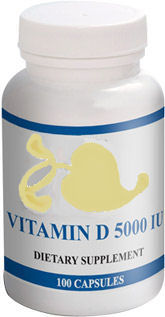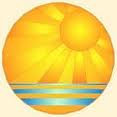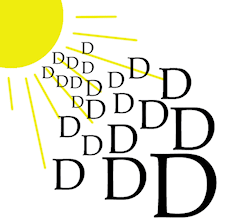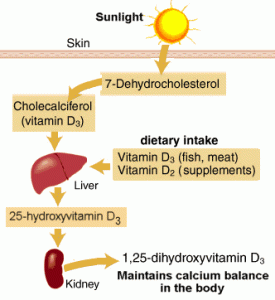
Featuring Vitamin D
Vitamin D — Paramount Chemical Messenger Quick facts about the importance of Vitamin D:
All of the above benefits come from the 1,25 dihydroxyvitamin D3 (active form) made in our kidneys. So supplementing with Vitamin D or even getting more sunshine may not work if our kidneys aren’t working well enough to convert the Vitamin D into the active form. What most helps in the process of creating this active form of Vitamin D are Parent Omega Oils, Vitamin K2 and Iodine. Make sure you get enough of these.
The reason Vitamin D is called the sunshine vitamin is because when rays of sunlight penetrate one’s skin, Vitamin D is created within the skin. Eventually, this Vitamin D is converted into active Vitamin D which provides all the health benefits mentioned above.A plethora of studies demonstrate categorically that Vitamin D is one of our body’s most important nutrients, furnishing the health benefits listed above.Why is November the Healthiest Month of the Year in northern hemispheres?There is a reason that November is historically the healthiest month of the year (in the Northern Hemisphere). The reason is that our bodies have been accumulating (during the spring summer and fall) Vitamin D, the Sunshine Vitamin, so that Vitamin D reaches its highest yearly level in the body in October. Contrastingly, the unhealthiest month of the year is February because by then body levels of Vitamin D have been depleted through lessened exposure to sunshine. People Do the Opposite of What is Prudent in Regard to the SunWhat is the first thing that most people d when they get sick? When they became older and infirm? Why they wrap themselves up in blanket, cloister them indoors, away from the health-giving sun rays that would give them Vitamin D. The hospitalized, the infirm seniors in nursing homes, even children and adults, when they are battling the common cold and could use more Vitamin D, confine themselves, indoors. This is 180 degrees the wrong way to act. People Wrongly Believe They Get Enough Vitamin D From FoodMany people falsely believe they get enough Vitamin D from milk or multivitamins.
How misled we are. There is no way to get enough Vitamin D from food. The best diet, even when drinking Vitamin D fortified milk, supplies only a few hundred units of Vitamin D. It is, also, very unlikely that you will get enough Vitamin D from the sun if you...
That’s why we have to supplement with Vitamin D and why we have to supplement with those additional factors that help the body to convert non-active forms of Vitamin D into the active form of Vitamin D. Those additional factors include: Vitamin K2, Iodine and Parent Essential Oils. |
|
  Vitamin D (Sunshine in a Bottle) Vitamin D (Sunshine in a Bottle)
Vitamin D is extremely important to health. In fact, with the possible exceptions of Oxygen and Iodine, and being a fat burner, it is virtually impossible to find something that is more important to talk about in the field of health than Vitamin D. One important thing that having optimum levels of Vitamin D does is to help ensure that calcium goes to the correct place, i.e. to the bones instead of into arterial calcification. Vitamin D is a do it or else suffer the consequences. If Vitamin D is at optimal levels in the body (either due to supplementation or preferably skin exposure to sunshine), then significant wellness benefits result. Conversely, if Vitamin D is not at sufficient levels, numerous health woes may be on their way.
Low Vitamin D and Degenerative Disease are LinkedThere is an extremely high degree of correlation between Vitamin D levels and degenerative disease. Medical scientists and researchers have found that serum Vitamin D levels are low in 90% of people with degenerative disease such as heart disease, cancer and autoimmune disease. Vitamin D is created in the human body when sunlight strikes the skin, which is why lifeguards have high levels of Vitamin D compared to other groups of people. Scientific researchers have assembled data showing that autoimmune diseases and cancer are largely absent from areas close to the equator. Because of this data many scientists believe that this indicates a correlation between high serum Vitamin D levels and lowered incidents of immune system disorders. They believe that because the angle of the sun is more direct near the equator, sunshine in equatorial regions stimulates a comparatively much larger production of Vitamin D in the human body than in areas further from the equator, and thus protects people living in those areas. Serum Vitamin D Levels Can Predict Your HealthThere is so much scientific evidence documenting the essential health roles of Vitamin D, showing that ill health corresponds to low levels of Vitamin D, that for one to not ensure optimal intake of Vitamin D is foolhardy. Going without Vitamin D for an extended period of time will result in cellular membrane damage that is not easily undone. Truly, an ounce of prevention is worth a pound of cure. Problem: The majority of people today in industrialized nations are under supplied with Vitamin D, usually getting 10 to 20 times less Vitamin D than their bodies could use. The average North American diet furnishes only 200 to 250 units of Vitamin D daily as opposed to an optimal intake of at least 4,000 units. Most people need 4,000 to 7,000 units daily for optimum health. What Are Adequate Serum Levels of Vitamin DThere are two measuring systems for reporting Vitamin D3 (the active form of Vitamin D) levels in the body. With the first method, optimum serum Vitamin D3 levels are between 125 to 200 nanomoles per liter, and with the second scale, 50 to 80 nanograms per milliliter. Using the first measuring scale, lifeguards have average serum Vitamin D3 levels of 165 and 130 nanomoles, respectively (66 ng/ml and 52 ng/ml in the second scale). But, the rest of us in North America and Europe are almost always below 75 nanomoles per liter (or 30 ng/ml). In fact, the majority of North Americans and Europeans are below 40 nanomoles per liter (10 ng/ml) and a very significant number are below 20 nanomoles per liter. We recommend that everyone read one or more of the Vitamin D reference articles listed at the end of this page. You may be astounded by what you learn. Unfortunately, some people may think that they are getting enough Vitamin D through the diet. The truth is that diet cannot supply adequate amounts of Vitamin D as shown in the below chart.
|
||||||||||||||||||||||||||||||||||||||||||||||||||||||||||||||||||||||||||||||||
|
||||||||||||||||||||||||
 |
Vitamin D3 Is Not An Island, Entire Unto Itself
Vitamin isolates are incomplete. This is also true with Vitamin D3. Specifically, Vitamin D3 has to be converted to active Vitamin D and this conversion process requires numerous other nutrients in creating the conversion. So make sure you eat a diet that is rich in nutrients (our modern Standard American Diet will not suffice). Especially important are Vitamin K2, Iodine and Parent Essential Oils.
Cited Vitamin D Research and Further Vitamin D Study References:
- The Uncensored Guide to Family Vitamin D
- Vitamin D and HIV
- Vitamin D in a New Light
- The Miracle of Vitamin D - is it for Real?
- Vitamin D Science
- Low Vitamin D Linked to High Mortality Rate
- The UV Advantage
Copyright 2008-2017 Healthy-Living.Org. All rights reserved.
These statements have not been evaluated by the Food and Drug Administration. No product mentioned herein is intended to diagnose, treat, cure or prevent any disease. If you are pregnant, nursing, taking medication, or have a medical condition, consult your physician before using this product.
The information on this website is intended as a sharing of knowledge and information from the research and experience of the Healthy-
Living.Org staff and contributors. It is not intended to replace a one-on-one relationship with a qualified health care professional and
it is not intended as medical advice. You should not use the information on this site for diagnosis or treatment of any health
problem or for modification of any medication regimen. You should consult with a healthcare professional before starting
any diet, exercise or supplementation program, before starting or discontinuing any medication, or if you suspect
you have a health problem. You should keep in mind that cited references to ongoing nutritional scientific
study are most likely not accepted by the FDA as conclusive. These references and mentions
of potential benefits are disavowed as product claims and are only included for educational
value and as starting points for your own research. No food or supplement can be
considered safe for all individuals. What may benefit 999,999 of a million people
may harm you. Therefore, no one can take responsibility for your health
except you in consult with your trusted health professional.

 Our bodies were designed to get Vitamin D from sunshine.
Our bodies were designed to get Vitamin D from sunshine. As direct sunlight reaches the skin (similar to plant photosynthesis), Vitamin D precursors are created in the skin tissue in large quantity and then converted by the liver and later the kidneys to the active form of Vitamin D known as 1-,25-dihydroxyvitamin D3. Other forms of Vitamin D3 obtained from supplements (there are minor amounts of forms of Vitamin D3 in cod liver oil and animal organs) are also converted by the kidneys to active Vitamin D3.
As direct sunlight reaches the skin (similar to plant photosynthesis), Vitamin D precursors are created in the skin tissue in large quantity and then converted by the liver and later the kidneys to the active form of Vitamin D known as 1-,25-dihydroxyvitamin D3. Other forms of Vitamin D3 obtained from supplements (there are minor amounts of forms of Vitamin D3 in cod liver oil and animal organs) are also converted by the kidneys to active Vitamin D3.